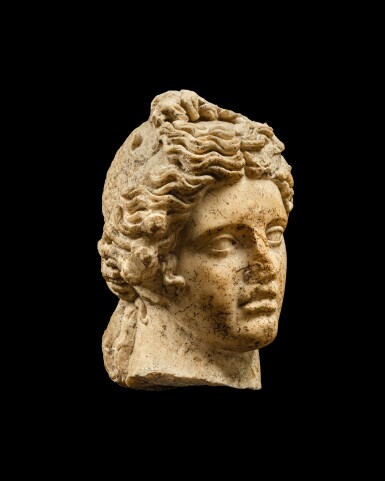Ancient Sculpture and Works of Art Part I
Ancient Sculpture and Works of Art Part I
Property from a Private Collection
A Roman Marble Head of Apollo, 1st Century A.D.
Auction Closed
December 7, 04:32 PM GMT
Estimate
250,000 - 350,000 GBP
Lot Details
Description
Property from a Private Collection
A Roman Marble Head of Apollo
1st Century A.D.
turned to his right, with parted lips, the luxuriant wavy hair centrally parted and bound in a fillet, the locks defined by deeply drilled channels, those above the forehead pulled up into a top-knot, those at the temple pulled back over the ears, a thick loop of locks covering the nape of neck, small curls escaping before and behind the ears, traces of three struts on the hair on the right; no restorations.
Height 30.4 cm.
reportedly discovered in Catania, Sicily
Ercole Canessa (1868-1929), New York and Paris
American Art Association - Anderson Galleries, New York, An important collection of rare and valuable antiquities; Gothic and renaissance furniture, important Italian Renaissance bronze, stone & marble sculptures, primitive paintings & early wood carvings, rare Greek & Graeco-Roman sculptures & pottery, gathered from famous European collections, by the late Ercole Canessa, March 29th, 1930, lot 115 (as "Greek, III Century B.C. Head of a Goddess)
Herbert Fleishhacker (1872-1957), San Francisco
with Butterfields, San Francisco, between 1967-1974
Dr. W. Kammer and Mr. Clifton F. Hart (Christie's, New York, December 5th, 2012, no. 86, illus., as "Apollo Lyceus")
acquired by the present owner at the above sale
Published
D. A. Amyx and B. A. Forbes, Echoes from Olympus: Reflections of Divinity in Small-Scale Classical Art, Berkeley, 1974, pp. 67, no. 1
University Art Museum, Berkeley, California, Echoes from Olympus: Reflections of Divinity in Small-Scale Classical Art, October 1st-November 17th, 1974
There is no other known Roman copy of the present head. For a statue of Apollo with a similar hairstyle see a statue in Rome, Museo Nazionale Romano: A. Giuliano, ed., Museo Nazionale Romano. Le sculture, vol. I.2, 1981, p. 327f., no. 33. For the thick loop of locks on the nape of neck see the Apollo Lykeios type (a replica was sold at Sotheby’s, London, June 13th, 2016, no. 21). The traces of three struts on the hair on the right side are intriguing: their size and relative distance to each other suggest that they could have been used to strengthen fingertips. If so, the complete statue must have raised the right hand close to the head, not unlike the Getty bronze athlete: https://www.getty.edu/art/collection/objects/7792. The Getty youth is represented in the act of crowning himself, but it is unclear how to reconstruct and interpret the motif in the case of Apollo.
The Canessa gallery was located at 1 West 50th Street in New York City, just off of Fifth Avenue. The online visual Library of the Museum of the City of New York contains several photographs of the gallery dated circa 1915. The interior views show European sculpture and works of art as well as antiquities displayed in lofty spaces similar in style and taste to those of the sprawling mansions built by financiers and industrialists in the late 19th/early 20th century up and down and off the upper reaches of Fifth Avenue. Many of these objects have come to rest in public collections. Among them are the Roman marble group of the Three Graces, now at the Metropolitan Museum of Art, and the Roman marble bust of a woman sold at Sotheby's, New York, December 9th, 2004, no. 280, now at the Michael C. Carlos Museum, Emory University, Atlanta, Georgia (https://collections.carlos.emory.edu/objects/12778/portrait-bust-of-a-priestess).







